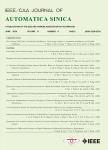Template-Based Gait Authentication Through Bayesian Thresholding
Template-Based Gait Authentication Through Bayesian Thresholding作者机构:IEEE the Department of Computer Science and EngineeringIndian Institute of Technology Madras the School of Electronics EngineeringVIT University the Department of Physiology and Biomedical EngineeringMayo Clinic the Department of Computer Science and EngineeringAnna University
出 版 物:《IEEE/CAA Journal of Automatica Sinica》 (自动化学报(英文版))
年 卷 期:2019年第6卷第1期
页 面:209-219页
核心收录:
学科分类:0810[工学-信息与通信工程] 1205[管理学-图书情报与档案管理] 12[管理学] 1201[管理学-管理科学与工程(可授管理学、工学学位)] 08[工学] 081104[工学-模式识别与智能系统] 080203[工学-机械设计及理论] 0802[工学-机械工程] 0835[工学-软件工程] 0811[工学-控制科学与工程] 0812[工学-计算机科学与技术(可授工学、理学学位)]
基 金:funded by Visvesvaraya Ph.D. Scheme for Electronics & IT from the Ministry of Electronics and Information Technology Government of India
主 题:Bayes’ rule biometrics gait recognition linear discriminant analysis verification
摘 要:While gait recognition is the mapping of a gait sequence to an identity known to the system, gait authentication refers to the problem of identifying whether a given gait sequence belongs to the claimed identity. A typical gait authentication system starts with a feature representation such as a gait template, then proceeds to extract its features, and a transformation is ultimately applied to obtain a discriminant feature set. Almost every authentication approach in literature favours the use of Euclidean distance as a threshold to mark the boundary between a legitimate subject and an impostor. This article proposes a method that uses the posterior probability of a Bayes classifier in place of the Euclidean distance. The proposed framework is applied to template-based gait feature representations and is evaluated using the standard CASIA-B gait database. Our study experimentally demonstrates that the Bayesian posterior probability performs significantly better than the de facto Euclidean distance approach and the cosine distance which is established in research to be the current state of the art.



